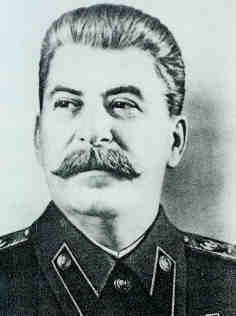
Soviet Russian dictator Joseph Stalin was a terrible enemy of the Ukrainian nation. He killed seven million Ukrainians in the 1933 famine. During World War II he also probably killed millions but the statistic is unknown.
Stalin was so paralyzed by fear of Hitler that there was not a word from him for a full 11 days after the German invasion on June 22. Finally on July 3, 1941 Stalin spoke on the radio and condemned the actions of "such fiends as Hitler and Ribbentrop" who had broken their pact of friendship. Stalin also announced a "scorched earth" policy for Ukraine: "In case of a forced retreat... all rolling stock must be evacuated, the enemy must not be left a single engine, a single railway car, not a single pound of grain or gallon of fuel. The collective farmers must drive off all their cattle and turn over their grain to the safe keeping of the state authorities for transportation to the rear. All valuable property, including non-ferrous metals, grain and fuel that cannot be withdrawn must be destroyed without fail. In areas occupied by the enemy, guerilla units....must set fire to forests, stores and transports."
The retreating Soviet officials, for example, shipped 6 million cattle from Ukraine east to Russia, 550 large factories, thousands of small factories and 300,000 tractors. The USSR also evacuated 3.5 million skilled workers from Ukraine to the Russian Republic. In the Battle for Ukraine Soviet sources say the partisans blew up nearly 5,000 enemy trains, blasted 607 railway bridges, 915 warehouses, and damaged over 1,500 tanks and armoured carriers.
As the Soviet authorities and army retreated from Ukraine in 1941, Stalin's scorched earth policy left a trail of destruction including the Dniprohes Dam on the Dnieper River, which was the largest hydro electric power dam in Europe, countless mines and major industrial factories, and Khreschchatik Street in the capital city of Kiev. On November 3, 1941 the famous architectural monument, the Dormition Cathedral in the Pecherska Lavra built 1073 in Kiev, was destroyed. Moscow tried to blame the Germans for destroying this superb example of medieval Ukrainian architecture but it was proven to be the work of a Soviet bomb squad which had mined it before their retreat and later set it off killing Germans.
Moscow also ordered the evacuation to the east of the Government of the Ukrainian SSR, the Ukrainian Academy of Sciences, all Kiev, Kharkiv and other university personnel, scientists, skilled technicians, Soviet bureacrats, and most NKVD (KGB) secret police to be evacuated east to Russia. The Ukrainian Government and the Academy of Sciences were relocated in Ufa, Siberia.
Since the Government of the Ukrainian SSR had fled the country there was no Ukrainian government on the territory of Ukraine during the war. As a result Ukraine was not a collaborator nation of Germany like Italy, Vichy France, Slovakia, Croatia, Finland, Hungary, and Romania. (In fact, Romanian, Hungarian and Italian forces occupied parts of Ukraine). Only the Italians were friendly to Ukraine.
It should be mentioned that an attempt was made to establish a Ukrainian government. On June 30, 1941 the Organization of Ukrainian Nationalists (OUN) headed by Stepan Bandera took the Germans by surprise by announcing the establishment of a new independent Government of Ukraine with Yaroslav Stetsko as Prime Minister. About one week later the Germans disbanded this government and arrested the members. Bandera and Stetsko were sent to Sachsenhausen Prison in Germany where they spent the war.
The Organization of Ukrainian Nationalists (OUN) supported the idea of an independent Ukraine. During World War II it was split in two factions called Melnykivtsi and Banderivtsi headed by Andrey Melnyk and Stepan Bandera. They both struggled against Nazi Germany and Soviet Russia and sometimes had divergent views with each other but they were united by the idea of indpendence for Ukraine. Moscow saw the Ukrainian nationalists as a dire threat and produced much Soviet propaganda blackening them especially Bandera who was accused of crimes against Ukrainians and Jews. The Kremlin also early in the War started a campaign of promoting patriotism with Russian (not Soviet) nationalism and chauvinism which culminated in the famous toast to the Russian people by Joseph Stalin on May 24, 1945.

Emblem of the Organization of Ukrainian Nationalists.

Stepan Bandera OUN Leader